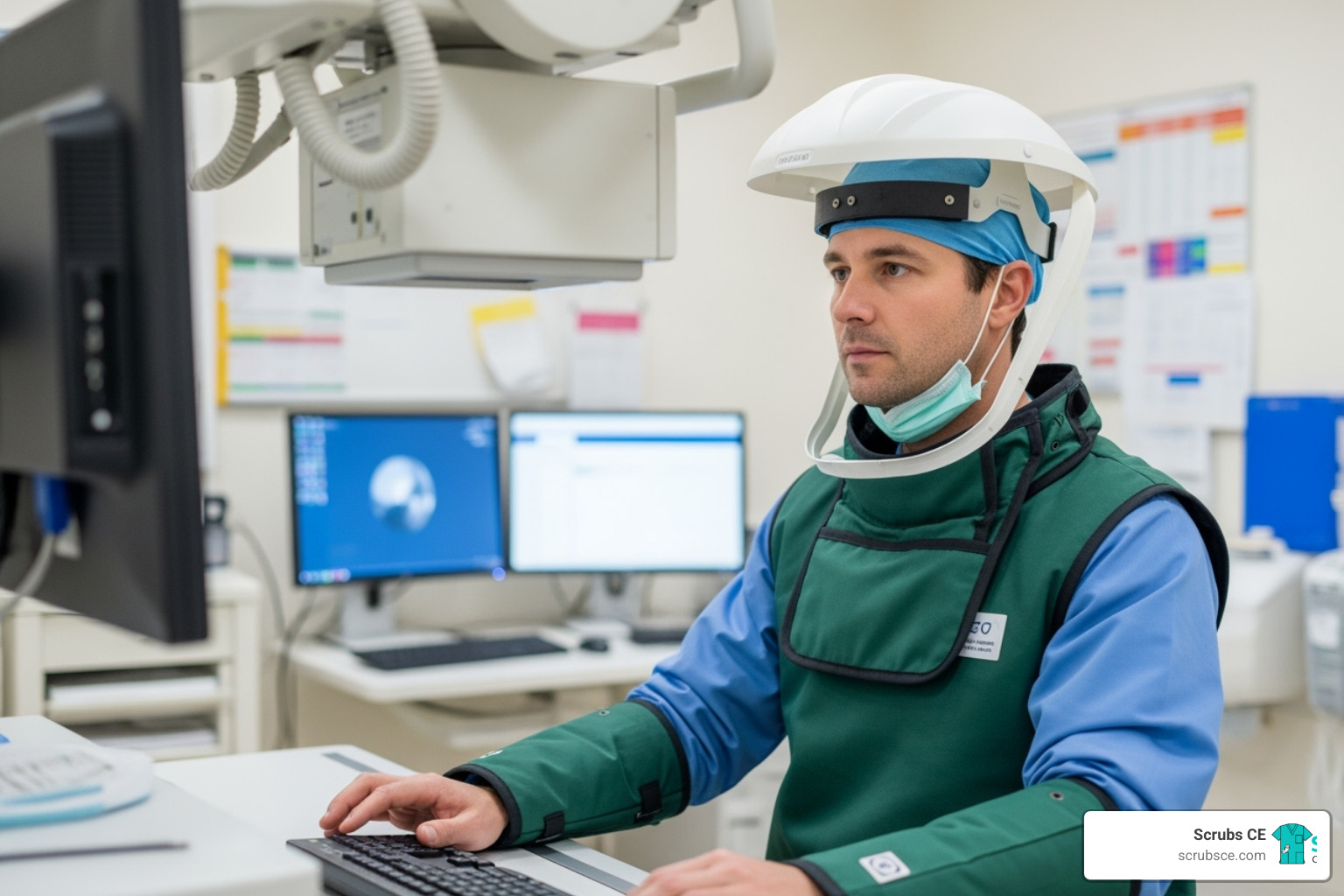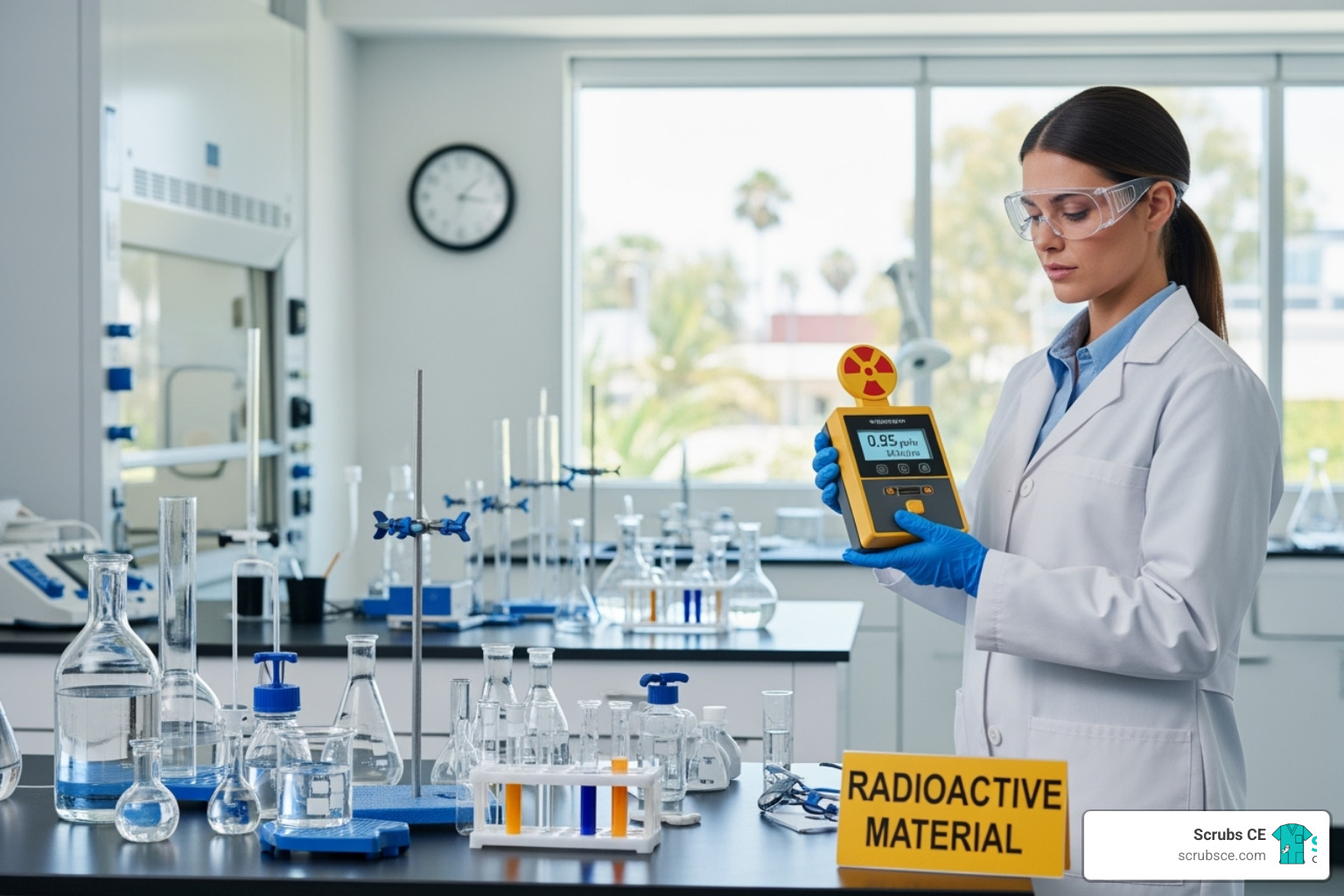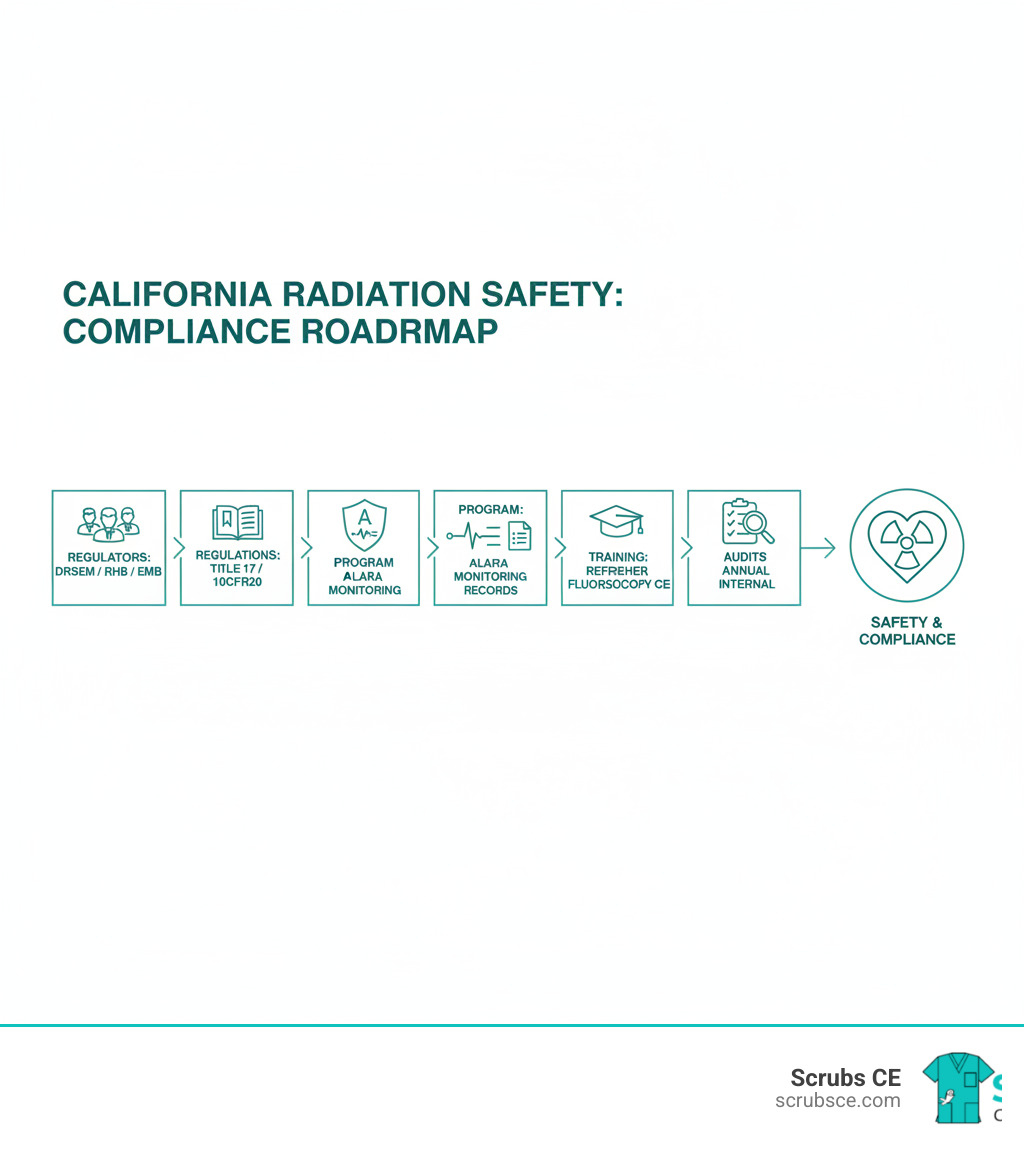Why California Radiation Safety Matters for Healthcare Professionals
California radiation safety is governed by a unique and stringent regulatory framework. The Division of Radiation Safety and Environmental Management (DRSEM) oversees all radiation sources through its two main branches: the Radiologic Health Branch (RHB) and the Environmental Management Branch (EMB). For any healthcare professional working with radiation in California, understanding these state-specific requirements is essential for compliance and safety.
California’s rules, found in Title 17 of the California Code of Regulations (CCR), often go beyond federal standards. Key aspects include:
- Dual Regulation: The state licenses radioactive materials as an NRC “Agreement State” and also imposes its own strict rules for all X-ray machines.
- Specific CE: Fluoroscopy users must complete 4 hours of radiation safety CE and 4 hours of digital fluoroscopy CE for permit renewal.
- Strict Dose Limits: The state enforces occupational dose limits, including lower limits for minors and declared pregnant workers, all under the ALARA (As Low As Reasonably Achievable) principle.
This guide provides a clear path through the California radiation safety landscape. We’ll cover the regulators, the rules, program requirements, and training mandates, so you can confidently meet state expectations.
Who Regulates Radiation in California: DRSEM, RHB, and EMB
In California, radiation safety is primarily managed by the Division of Radiation Safety and Environmental Management (DRSEM), a part of the California Department of Public Health (CDPH). DRSEM’s mission is to protect Californians from radiation and environmental hazards through regulation, monitoring, and emergency response. Understanding its structure is key to navigating California radiation safety.
DRSEM operates through two main branches:
Radiologic Health Branch (RHB) responsibilities
The Radiologic Health Branch is the primary point of contact for most healthcare and industrial radiation users. RHB’s responsibilities are focused on ionizing radiation and include:
- Licensing and Registration: Issuing licenses for radioactive materials and registering all X-ray machines in the state.
- Certification and Inspection: Certifying equipment operators and conducting facility inspections to ensure compliance.
- Incident Response: Investigating radiation-related incidents and monitoring for environmental contamination.
Environmental Management Branch (EMB) responsibilities
The Environmental Management Branch handles a broader scope of environmental health issues that support the state’s safety infrastructure. Its duties include:
- Waste and Hazard Management: Regulating medical waste, managing the state’s indoor radon program, and overseeing radiological cleanup at sites like former military bases.
- Emergency Preparedness: Coordinating the state’s response plans for nuclear emergencies.
Together, RHB and EMB provide comprehensive oversight, ensuring that California radiation safety standards are met across all sectors, from medical facilities to industrial sites.
California Radiation Safety Regulations, Duties, and State–Federal Differences
Navigating California radiation safety means understanding a layered system of state and federal rules. The specifics are detailed in Title 17, Division 1, Chapter 5, Subchapters 4 and 4.5 of the California Code of Regulations (CCR), which builds upon federal standards like 10 CFR Part 20.
As an “Agreement State” with the U.S. Nuclear Regulatory Commission (NRC), California has the authority to regulate most radioactive materials. The state’s regulations must be at least as strict as the NRC’s. California incorporates federal standards like 10 CFR Part 20 (“Standards for Protection Against Radiation”) directly into its own code, creating a consistent safety baseline.
You can explore the full text of these regulations here: Browse Title 17 – California Code of Regulations
Employer and employee responsibilities under California law
Both employers and employees have clear responsibilities defined in regulations and official notices like CDPH Form RH-2364 (“Notice to Employees”).
Employer responsibilities include:
- Ensuring full compliance with all state regulations and license conditions.
- Providing access to regulations, licenses, and operating procedures.
- Posting any notices of violation and providing employees with their radiation exposure data, including annual reports upon request or if a dose exceeds 100 mrem.
- Delivering comprehensive initial and refresher radiation safety training.
Employee responsibilities include:
- Understanding and following all applicable radiation protection standards and procedures.
- Promptly reporting any unsafe conditions or potential violations.
- The right to request inspections from the CDPH without fear of retaliation.
- The right to access personal exposure records and speak privately with inspectors.
To ensure transparency, facilities must post current copies of 17 CCR, 10 CFR 20, operating procedures, Form RH-2364, and any violation notices.
California vs NRC: what agreement-state status means
While California’s rules for radioactive materials are comparable to the NRC’s, the state sets itself apart with its regulation of all X-ray producing machines. The NRC has very limited jurisdiction over X-ray equipment, but California’s CDPH-RHB enforces extensive, state-specific requirements.
These additional rules for X-ray facilities often involve detailed engineering, shielding design, safety interlocks, and facility survey mandates that go beyond federal guidelines. Incident reporting protocols are also state-specific, with reports going directly to the CDPH-RHB.
The table below highlights key differences:
| Feature | Federal Regulations (NRC) | California Regulations (CDPH-RHB) |
|---|---|---|
| Scope of Authority | Byproduct, source, and special nuclear materials (non-Agreement States) | Byproduct, source, and special nuclear materials (Agreement State authority), ALL X-ray machines |
| X-ray Jurisdiction | Limited to certain federal facilities (e.g., VA hospitals) | Full jurisdiction over all medical, dental, industrial, and academic X-ray installations |
| X-ray Requirements | General safety standards (e.g., 21 CFR) | Additional, state-specific engineering, design, shielding, and survey requirements (Title 17) |
| Radioactive Materials | Licensing and enforcement for materials under NRC purview | Licensing and enforcement for materials under Agreement State purview (comparable to NRC rules) |
| Posting Rules | General requirements for notices, licenses, procedures | Specific list of documents to be posted, including CDPH Form RH-2364 |
| CE Expectations | Varies by profession, generally not direct NRC mandate | Specific mandates for certain users (e.g., 4-hour fluoroscopy safety, 4-hour digital) |
| Regulatory Document | 10 CFR Parts 19, 20, 30, 35, etc. | 17 CCR Div 1, Ch 5, Subch 4 & 4.5, incorporates 10 CFR 20 by reference, Health & Safety Code |
The takeaway is clear: operating in California requires adherence to both the federal baseline and the state’s additional, often more stringent, requirements, especially for X-ray equipment.
Building a Compliant Program: ALARA, Monitoring, Records, and Emergencies
A compliant California radiation safety program is built on a culture of safety, centered on the ALARA principle: keeping radiation exposure As Low As Reasonably Achievable. This goes beyond simply staying below legal dose limits; it involves actively minimizing exposure through engineering controls, clear procedures, and diligent oversight. The CDPH provides detailed guidance for building your program.
For the full picture, take a look at the official guidance:
Radiation Safety and Protection Program Requirement Guidance (CDPH)
Key Program Components
1. ALARA Program and Governance:
Your program must have a formal ALARA policy and conduct an annual program audit to ensure its effectiveness. The Radiation Safety Officer (RSO) is central to this, holding the authority to stop unsafe work and ensure all program elements are implemented and reviewed.
2. Personnel Monitoring and Dose Limits:
Protecting people is paramount. Key dose limits are:
- Adult workers: 5 rem per year (TEDE).
- Minors (under 18): 500 millirem per year.
- Embryo/fetus of a declared pregnant worker: 0.5 rem over the entire pregnancy.
Personnel dosimeters are required for anyone likely to receive over 10% of the annual limit and must be worn correctly (e.g., at the collar, outside lead aprons).
3. Area Controls and Surveys:
Areas with radioactive materials or radiation-producing machines must be designated as controlled areas with restricted access and proper signage (“CAUTION RADIATION AREA”). Regular surveys are required to check for contamination and measure exposure rates. All survey meters must be calibrated regularly, and sealed sources must undergo periodic leak testing.
4. Records and Reporting:
Meticulous record-keeping is non-negotiable. You must maintain logs for:
- Training: Who was trained, when, and on what topics.
- Exposure: Individual dose records for all monitored personnel.
- Instrument Calibration: Proof that your safety equipment is accurate.
- Incidents: Any overexposure, spill, or loss of material must be reported immediately to the CDPH-RHB, followed by a written report. Transfers and disposals of sources must also be documented.
5. Emergency Response:
Your facility needs a clear plan for emergencies. For spills, the protocol is to vacate, contain, and notify the RSO. For injuries involving radioactive material, medical care is the priority, but the RSO must be notified immediately to manage contamination.
California-Specific Requirements
X-ray Installations:
California’s Title 17 imposes strict rules for X-ray facilities beyond federal standards. This includes mandatory specifications for shielding design, safety interlocks on doors that terminate exposure, and required facility surveys to verify safety. Bypassing these safety features is a serious violation.
TITLE 17—additional X‑ray installation requirements (Stanford EH&S)
Radioactive Waste Disposal:
Waste must be carefully segregated by radionuclide, half-life, and form. Decay-in-storage is used for short-lived isotopes, while long-lived waste requires licensed waste brokers for disposal, following all Department of Transportation (DOT) regulations.
Industrial Radiography:
This high-risk field has stringent RSO duties, including the explicit authority to stop unsafe work. Key requirements include annual refresher training, semi-annual performance observations of radiographers, and quarterly physical inventories of all sealed sources.
Training, Fluoroscopy Requirements, and Practical Resources
Effective training is the cornerstone of California radiation safety. It empowers you and your team to understand and mitigate the risks of radiation exposure, protecting yourselves and your patients.
Fluoroscopy-specific education and permits
For professionals performing fluoroscopy, California has very specific continuing education (CE) mandates. These are critical for maintaining your fluoroscopy permit.
- 4 hours of CE on fluoroscopy radiation safety: This covers radiation physics, biological effects, and dose reduction techniques like collimation and pulsed fluoroscopy.
- An additional 4 hours of CE on digital fluoroscopy: This training focuses on the unique dose management considerations of digital systems, including automatic exposure control and PACS integration.
Meeting these requirements can be challenging with a busy schedule. At ScrubsCE.com, our courses are self-paced, accessible online 24/7, and provide instant certificates. We make it easy and affordable to stay compliant.
- Learn more: Why You Should Take Your Fluoroscopy Radiation Safety CEs for California
- Save money: Satisfy California Fluoroscopy CME Requirements on a Budget
- Renew with ease: California Fluoroscopy License Renewal: How to Maintain Your Fluoroscopy Permit in the State of California
- Get started now: Fluoroscopy CE Courses
Beyond fluoroscopy, all personnel working with radiation need initial and periodic refresher training covering health risks, safety procedures, and emergency response.
Equipment, shielding, and vendor essentials
Proper training must be paired with the right equipment and facility design.
- Personal Protective Equipment (PPE): Lead aprons, thyroid shields, and leaded glasses are your first line of defense against scatter radiation.
- Survey Meters and Dosimetry: Calibrated survey meters are essential for real-time area monitoring, while dosimetry services provide badges to track personal cumulative exposure.
- Facility Shielding: Structural barriers like lead-lined walls and doors are engineered to meet California’s strict Title 17 requirements, protecting staff and the public.
- Maintenance: All radiation-producing equipment requires regular maintenance and quality assurance checks to ensure safe and accurate operation.
Frequently Asked Questions about California radiation safety
What is the scope of Title 17 for X-ray vs radioactive materials?
Title 17 incorporates federal standards (10 CFR Part 20) for radioactive materials but imposes additional, state-specific requirements for all X-ray machines. These state rules cover shielding design, safety interlocks, and facility surveys.
What are the key differences from NRC regulations?
The biggest difference is jurisdiction over X-ray machines. The NRC has very limited authority, while California regulates all X-ray installations in the state. This means compliance for X-ray use is primarily a matter of state, not federal, law.
What are the basics for reporting and posting?
Employers must post the “Notice to Employees” (CDPH Form RH-2364), relevant regulations, and operating procedures. Employees have a right to their dose reports. Incidents like overexposures or lost sources must be reported to the CDPH-RHB immediately, followed by a written report.
Conclusion and Next Steps
Navigating California radiation safety is a critical responsibility. By understanding the roles of DRSEM and its branches, adhering to Title 17, and implementing a robust ALARA-based program, you can ensure a safe and compliant environment for both staff and patients.
The compliance roadmap involves knowing the regulators, following the rules, maintaining a strong program, and ensuring comprehensive training. This framework is essential for every radiologic technologist, fluoroscopy operator, RSO, and physician in the state.
We know meeting California’s specific fluoroscopy CE requirements—the 4 hours of radiation safety plus 4 hours of digital fluoroscopy training—can be a challenge. ScrubsCE.com was created to solve this problem. Our online, self-paced courses are designed for busy professionals, offering instant certificates upon completion so you can meet your licensure requirements without stress.
Ready to complete your California radiation safety CE? Our California Combos bundle the exact courses you need at a budget-friendly price.
Radiation safety is about creating a culture of protection. With the right knowledge and training, you can confidently exceed California’s standards and contribute to a safer healthcare environment.








Recent Comments